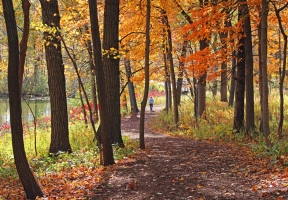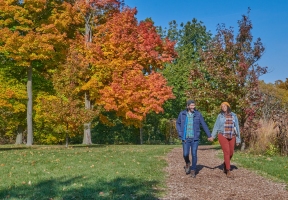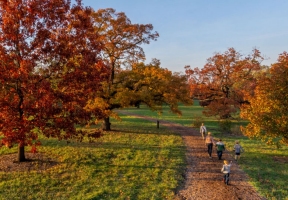By: Ashmar Mandou
 With a kaleidoscope of reds, oranges, and yellows, the crisp cool air, the scents of cinnamon and wood smoke, and the lively sounds of rustling leaves, it is easy to understand why many relish in the autumn season. But what makes this season so magical, especially when we take in the sight of the changing foliage? We had an opportunity to speak with Dr. Christy Rollison, senior scientist in Forest Ecology at The Morton Arboretum about what impacts the beautiful fall foliage, certain trees to keep on the radar, and what fun fall activities are at The Morton Arboretum.
With a kaleidoscope of reds, oranges, and yellows, the crisp cool air, the scents of cinnamon and wood smoke, and the lively sounds of rustling leaves, it is easy to understand why many relish in the autumn season. But what makes this season so magical, especially when we take in the sight of the changing foliage? We had an opportunity to speak with Dr. Christy Rollison, senior scientist in Forest Ecology at The Morton Arboretum about what impacts the beautiful fall foliage, certain trees to keep on the radar, and what fun fall activities are at The Morton Arboretum.
Lawndale News: We are officially in autumn, a favorite season for many due to the foliage. With most days on the warmer side, how does that impact the fall color?
Dr. Christy Rollison: In general, warm weather will delay fall color. However, there’s a difference between warm and hot, which is what we’ve been getting in late September. When we say a warm fall typically delays fall color, that’s associated with temperatures not getting down close to freezing, allowing trees to continue growing for longer. Temperatures over the past weekend and forecasted this first week of October are warm enough that trees need to use a lot of water to grow. So what we’re seeing instead is increasingly early color as high temperatures exacerbate water stress since we haven’t had a lot of rain lately.
LN: What are the optimal temperatures for prolonged fall colors?
Dr. CR: This is a good question and a tough one to answer, because there probably isn’t a single set of “optima” for prolonged fall colors. However, a good, long, fall color season probably occurs in a moderate fall where each species is able to really have its moment and take its time senescing. This means that the classic fall conditions associated with classic fall weather – warm days, cool/cold evenings, some rain, but otherwise sunny – are what let trees know it’s time to start preparing for winter with plenty of time before cold and snow really set in.
LN: Are there certain trees that people should keep on their radar for peak fall color?
Dr. CR: Maples are the typical show-stoppers when it comes to fall color and are known for vibrant reds and oranges. One of my personal favorites is ginkgo, whose leaves turn a golden yellow that all fall in a day or two. Oaks can be really underrated for fall color and the oak collection at The Morton Arboretum can provide an amazing display of orange, red, and maroon in late October under the right conditions. Right now, trees that typically change early such as honeylocust or highly exposed maples such as those that are in parking lots are the ones giving the best color. Look for early yellow and brown colors on Freeman maples, coffee-trees, tree lilacs, hackberries, and redbuds. All are showing early yellows and are dropping some leaves.
LN: What fall related activities can people enjoy at the Morton Arboretum?
Dr. CR: The fall season marks the start of the Arboretum’s annual Fall Color Festival, with festivities for all ages throughout October. Visitors can hike 16 miles of trails through our vibrant tree collections, drive or cycle nine miles of scenic roads, or enjoy fall-themed special events and the Vivid Creatures outdoor art exhibition all season. Special events include the Cider and Ale Festival, Oct. 4; 15th annual Glass Pumpkin Patch, Oct. 10 through 12; Fall Wine Tasting, Oct. 16; Fall Color 5K Run and Walk, Oct. 25; and Walking Plays: “Farewell, Mr. Poe”, weekends Oct. 4 through Oct. 26. Visitors can check out, mortonarb.org, for information and to purchase tickets. Seasonal concessions will be available Fridays through Sundays, Oct. 3 through Oct. 26, and on Monday, Oct. 13 (Indigenous Peoples’ Day) from 11 a.m. to 3:30 p.m. in the Arbor Court area outside the Visitor Center, including apple cider doughnuts, taffy apples, cotton candy, warm kettle corn, warm pretzels, chili and a selection of craft beers and warm beverages.
LN: What tips do you have for people on how to use their leaves after they’ve fallen?
Dr. CR: Leaves can be really helpful for maintaining forest health. The decomposition of leaves is really important for cycling nutrients back into the soil as well as helping maintain soil temperature and moisture. Shredding leaves and leaving them in your lawn can work well, but you can rake leaves into beds for mulching and insulation or compost them (after jumping in your leaf piles, of course!) to make the most of the benefits your trees provide to you.


Photo Credit: The Morton Arboretum











